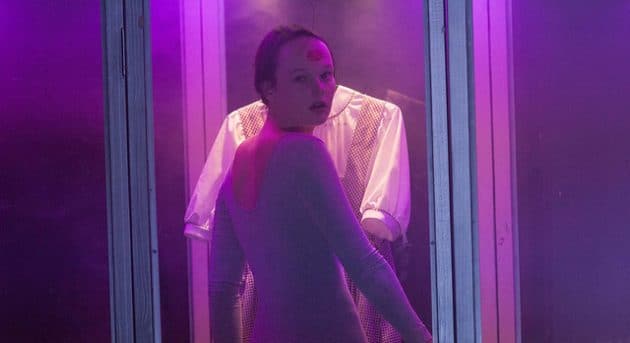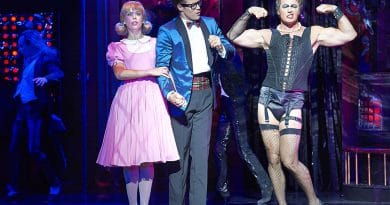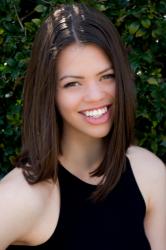The Wizard of Oz — Belvoir
It started with a dog, in a perspex case, alone on stage. It ended with an elderly ‘Dorothy’ (Eileen Kramer) dancing in a wheelchair. What happened in between made no more sense.
Adena Jacobs’ novel appropriation of Frank L. Baum’s classic folklore The Wizard of Oz is a wordless, for the most part, loosely plotted, series of dream-like vignettes set in a stark concrete room, with an overwhelming mystical soundtrack and lighting plot, that enthrals the audience.
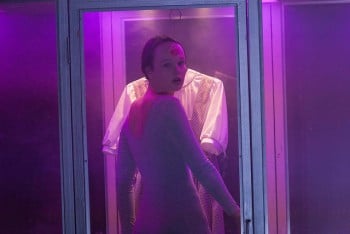
This journey through Oz begins when Dorothy (Emily Milledge) enters to find a dead witch lying naked on the floor with her famous red shoes; Dorothy takes them for herself. After this recognisable scene, the story we know and love is warped into some strange distortion that I was able to follow, somewhat distantly, only due to my familiarity with the film.
Through a series of scenes Dorothy meets her travel companions as they appear behind a thin curtain that is zipped on and off stage. First, she meets the scarecrow (Melita Jurisic) who is tied up by her wrists, and costumed in ragged clothes with a stocking over her face. After recounting her story, a disturbing sequence follows in which the scarecrow runs around the stage shrieking and laughing manically, a clear demonstration of her brainlessness. Dorothy frees the scarecrow from her confining ropes and an oddly timed dance sequence ensues. The scarecrow walks off without warning, leaving Dorothy to roam the stage aimlessly, a moment that is repeated multiple times throughout the show.
Dorothy then meets the Tin Man (Jane Montgomery Griffiths) who similarly shares her story before leaving Dorothy perplexed and alone on stage.
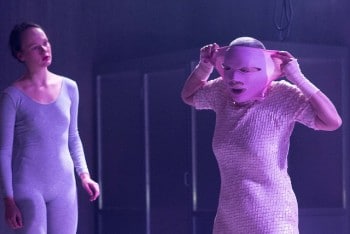
Finally, Dorothy comes across the Lion (Paul Capsis) who gives a stunning and humorous rendition of ‘Always Chasing Rainbows’ before too leaving Dorothy. All these characters provide a unique twist on what we expect them to be and present desolate creatures aching from something lacking in their lives. They capture the audience’s interest with their unique stories and attention-demanding actions, yet fail to attain any genuine sympathy as their peculiar nature distances them from the audience’s empathy. After Dorothy meets all her troubled friends, the plot seemed to lose all flow.
At some point in a series of surreal vignettes, Dorothy is confronted by her traditional nemesis the Witch (Luisa Hastings Edge). In this production the witch reappears multiple times, in different costumes, and seems to have a different emotional impact on Dorothy each time, sometimes alluring and friendly; other times, frightening and threatening. The witch doesn’t succumb to the boundaries or expectations presented, and finds her power in her own individuality and sexuality.
The show drags on through a sequence of ‘scenes’ that are difficult to follow and become odder as they progress. The show culminates in the recognisable image of Dorothy confronting her enemy, yet instead of a water bucket, in a provoking image, Dorothy, dressed as the Witch, desperately hurls black water balloons at the Witch’s bare back before undressing and assuming the position of the dead witch that she encountered upon first entering the stage. Roles have been reversed and the audience is forced to question their understanding of the traditional tale.
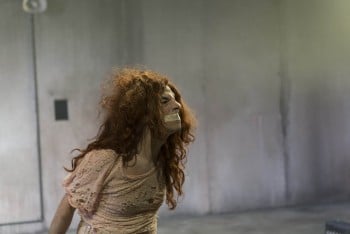
Whilst the show was difficult to comprehend and thus unsatisfying, the production elements were overall well done. An immersive experience was promised, and undoubtedly delivered. The sound design (by Max Lyandvert) varied from eerie and mystical, to cheery, to overwhelmingly threatening. The lighting design (by Emma Valente) similarly guided the audience through an emotional journey as it changed from stark and bland, to dark and ominous, to altogether disorientating, shaping the scenes and aiding our comprehension of the scene transitions. The sound and lighting combined with the unembellished setting (by Ralph Myers) and decrepit costumes (by Kate Davos), which provided a twisted reimagining of the traditional costuming, were extremely fitting for this remodelled classic.
This piece was consistent in its deliberate restructuring of the traditional story in order to provoke the audience to engage deeply, and particularly consistent in the motifs of fear, dreams, and vulnerability it presented. Whilst many of the scenes were hit and miss, some had profound displays of raw emotion. Particularly well explored in this piece was the idea of vulnerability and brokenness. A stark example of this was the penultimate scene as the witch stood naked, watching Dorothy undress. Both women had lost all power they once possessed, and were in their most vulnerable and damaged states. The witch had been humiliated and hurt through Dorothy’s attack, and Dorothy herself had come undone through taking on the role as the aggressor.
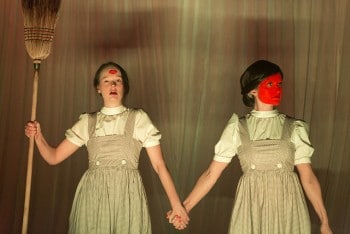
The notion of fears and hopes that can only be truly optimised within a dreamlike state were also well developed. Particularly through some of the more threatening and disturbing images that were not only frightening to Dorothy but also to the audience, such as when she was spun in the Perspex case as the strobe lights and music reached an overwhelming intensity.
Jacobs’ vision of Oz is boldly different to what most audiences will expect. For those that enjoy deconstructing and engaging deeply in images and actions, without the aid of a clear narrative structure, this avant-garde piece is probably for you. But for the most part, this piece whilst fascinating to watch unfold, was beyond my understanding and empathy.

